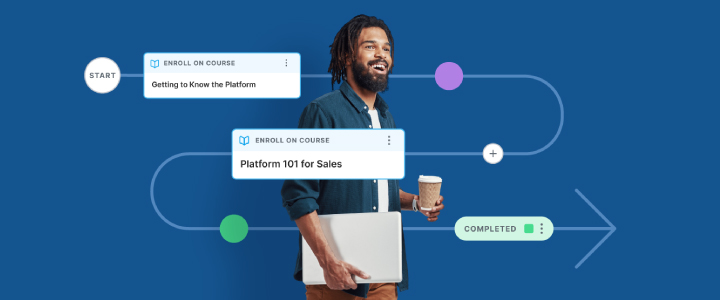
4 min reading time
Effective Training Methods for Your Online Learning Programs
Have you recently switched from in-person to online training? Most learning leaders and trainers have had to quickly embrace this major shift over the last year. And with many being thrown in at the deep end of remote learning, we wanted to help. This post explores the different types of training methods you can use to create effective online learning programs.
Clear objectives are key
Before you can choose a training method, or even create a course, you’ll need to know the objective of your training. Keep in mind what you want to achieve through this training. Setting this will give clarity to your learners and create a clear path to reaching your business’s learning goals.
Training objectives are the intended measurable outcome that your learners will achieve once they’ve finished a course. When creating them, it’s crucial to detail the knowledge that will be acquired and what learners will be able to achieve through learning this information.
Keep them concise, and use focused statements that break down what each course will accomplish. And, importantly, how they will help reach the business’s goals.
With your objectives set, it’s time to find the best online training methods for your learners.
Types of online training methods
There are many different ways of engaging your learners. It’s likely that over the course of a training programme, you’ll need to combine different types of training methods to get the best results. Here, we explore some of the most successful types of training for online learners.
Webinars/Live learning sessions
Easy to use and with no shortage of software options, webinars or live learning sessions are a key method to utilize within online learning programs. You have the ability to carry out virtual instructor -led classrooms, which have similar aspects to in-person ones. For example, in many webinar tools, learners have the option to raise their hand to ask a question or share feedback, making the experience as close to in-person as you can get.
Many learning management systems (LMS) give you the ability to integrate with a webinar tool. If you have access to an LMS, we recommend that you switch webinar integrations on. The advantages are huge – your scheduling, registration and attendance records are centralized within your LMS, reducing time-consuming admin tasks associated with manually managing this training method.
Webinars are the perfect training type to repurpose for future course content. Done in a couple of clicks, you can record your sessions and save them for later. If you’re using an LMS, it’s a simple case of uploading the recordings and adding them as a module or course in your online training programs.
Our favorite webinar tools are MS Teams, GoToWebinar, Zoom and Webex, but you can use the webinar tool you’re most comfortable and familiar with.
Videos
Another learning method we love – video. Whether it’s an employee onboarding video or a product demo for customers, a training video’s sole purpose is educating or instructing your learners on a specific topic, to teach a skill or share information.
You can use a variety of methods to create a video for online training, and there’s an abundance of software to help you. Our favourite video editing software has to be Camtasia by TechSmith. For example, when you have a process or product functionality to explain to your learners, sometimes the spoken word isn’t the best way to communicate this information. Instead, try using screen capture. This allows you to quickly record a process so you can show your learners how to do it instead of telling them.
Another great way to make video a training method, is through PowerPoint. This is handy because it means any presentation you have on file can be repurposed for training. Remember that course content doesn’t always have to be built from scratch! It’s as simple as converting your existing PowerPoint presentations to video. You can even add a voiceover to talk through the presentation and capture your learners’ attention.
Social learning
Social learning plays a significant role in knowledge retention, making it a key online training method. Think about it – when people get involved in an important or lively discussion, they tend to recall the information better. Why? Because they contributed to the topic and, as a result, relate to it on a personal level.
If you have a learning management system, make it a priority to encourage discussions within your LMS forum.
This provides an environment where learners can:
- Contribute and interact
- Observe the contributions and conversations of others
Learners can observe the discussions of others, enabling them to learn from the experiences of others and gain new perspectives.
If you don’t have access to a learning management system, we recommend creating a ‘Learning’ channel within your internal messaging system. That way, your learners can still ask questions and easily discuss each course with their fellow learners.
Is there an easier way?
While each of these online training methods can be used on a standalone basis, they are often much more effective when used in combination. But, these siloed methods can become synchronized through centralized storage. If you don’t have access to an LMS, our best advice would be to keep all your training materials and courses stored in one place, and to keep an inventory of each course, the training methods used and all associated content.
To learn more about how an LMS can help you centralize your training, check out how CENTURY 21 Affiliated adapted and embraced remote learning at lightning speed, or how Premium Retail Services implemented forward-thinking online training strategies.



